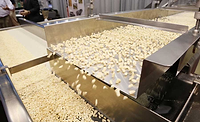Food Safety
How processors can improve supply chain safety
New regulations, blockchain buzz and consumer demand have new ideas swirling about how connected partners should be when tracking food and keeping it safe

Tracking ingredients is the norm for processors inside their plants, but a collection of reliable, accurate data about every step of the supply chain will help improve recall traces and consumer confidence in the food safety.
Photo courtesy of Getty Images
Blockchain: Possibilities and challenges
What is blockchain?
Think of it as a shared digital record book. The platform is most commonly known for logging bitcoin transactions. Similar to a shared database, blockchain has key differences: mainly that users can’t alter or delete records.

From a conference on SAP’s Leonardo intelligent technologies, including blockchain applications.
Photo courtesy of SAP
How would it work?
All supply chain partners for a product or ingredient would add key information about movement of items into the shared blockchain network. University of Florida Professor Bruce Welt, coordinator of the Packaging Engineering Program, suggests adopting an established system of recording critical tracking events to capture “what, where, when”: Where and when did an item pass through a key point along its journey, such as a delivery or pesticide application? Who (which worker or business) had possession at those points?
How would it help the supply chain?
Blockchain doesn’t help on its own, Welt and other experts say. The blockchain only holds data. Before businesses could adopt blockchain, they would have to upgrade their tracking to collect the rich, digitized data needed to make it useful. That would be a big change for many companies.
What are some advantages?
A central data location should allow inspectors and epidemiologists to narrow in on the path and origin point of some recalled food much more quickly. The average company could join a blockchain without deep IT expertise. No company up or down the chain would control the data, and individual businesses’ data remain private.
Welt is among observers who expect that the new information collected could provide savings to help balance implementation cost. For example, companies might be able to make faster decisions to divert delayed produce to a closer location before it goes bad.
“There’s some real-time savings and intelligence that could come out of a system like that,” he says.
What are some possible challenges?
Welt, while supportive of blockchain as one possible recording method, says improved tracking data still would be helpful in distributed databases, often managed now by individual companies or cloud providers. He’s unsure whether an unalterable, possibly permanent record is efficient to record movements of perishable products, many that zip through the supply chain before spoiling.
“There are many ways of handling the distributed data,” he says. “Blockchain is just one of them, and it may be a good one, it may not be a good one. We don’t know yet.”
A closer look at SAP’s blockchain development
SAP didn’t intend to put out its own blockchain offering but changed course after a customer survey earlier this year found strong demand, says Gil Perez, SAP’s senior vice president of products and innovations and head of digital consumer initiatives. About 92 percent of respondents indicated they would join a consortium led by the company that serializes many products and gives them digital birth certificates.
SAP is focusing on blockchain for specific industries, in response to customers’ misgivings about joining a large consortium, Perez says.
Some other SAP survey findings:
- Early stages: 3 percent use blockchain in production, but 84 percent are involved in blockchain-related activities
- Usefulness: Respondents expect the most promising use to be in the supply chain and IoT
- Help with regulation: 96 percent expect blockchain to improve compliance
- Perez describes how he sees traceability evolving:
- Clusters of partner businesses could start using blockchain and add others in their supply chain as they’re ready to join.
- He expects DNA serialization to become reality someday, with samples of food genetic markers used to track items with potential problems later in the supply chain.
- While data can’t be removed in a blockchain, SAP is experimenting with networks that could be eliminated after years when old information isn’t wanted.
- Starting with groups of companies using separate blockchains will work well, and technology developments will find a way to consolidate them later, if needed.
“We are definitely very much invested in this area. We think it’s going forward very quickly,” he says.
Looking for a reprint of this article?
From high-res PDFs to custom plaques, order your copy today!






